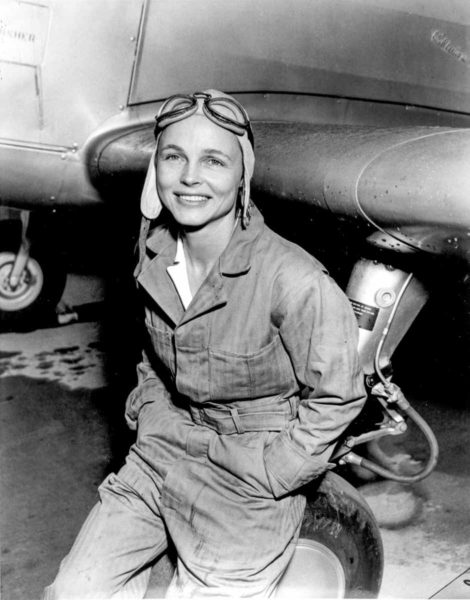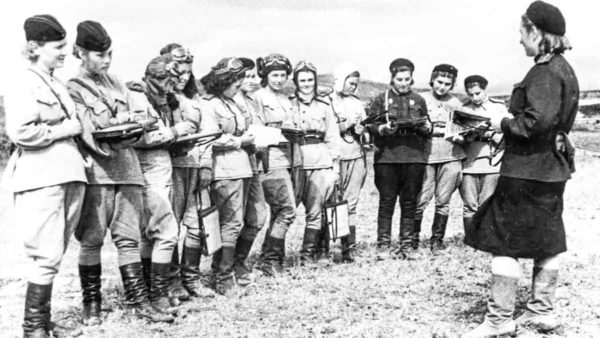Last year I wrote a blog about a Soviet all-female combat air regiment created to pilot rickety biplanes for the purpose of bombing German military targets after Hitler’s decision to invade the Soviet Union in June 1941. Die Nachthexen, or “Night Witches” were so feared by the Germans that any soldier or pilot who downed a Night Witch aircraft automatically earned the Iron Cross medal. (Click here to read the blog, The Night Witches.)
Today’s blog will focus on other Soviet fighters feared by the Germans. These were the Soviet women trained to be snipers and they were deadly. In fact, one of them was well-known to German soldiers. Her nickname was “Lady Death.”
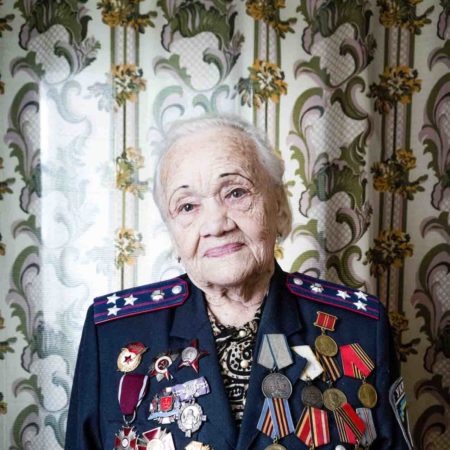
Did You Know?
Did you know that many historians have pegged SS-Oberführer Oskar Dirlewanger (1895−1945) as the cruelest Nazi during the Third Reich? Considering the magnitude and depth of atrocities committed by the Schutzstaffel (SS) and others during the war, Dirlewanger must have been a particularly nasty individual with no conscience.
Joining the SS armed division, the Waffen-SS, Dirlewanger was given command of what became known as the “Dirlewanger Brigade.” One of his first assignments was as commandant of a labor camp. Investigated by the SS, he was accused of murder and corruption. Dirlewanger had young Jewish women injected with strychnine because he enjoyed watching them convulse to death. His leadership style encouraged drunkenness, looting, sadistic atrocities, rape, and murder. Himmler knew all about Dirlewanger but tolerated his behavior.
The Dirlewanger Brigade was assigned in 1942 to hunt down partisans in Belarus. His favorite tactic was to round up villagers and herd them into a barn. His men would set the barn on fire and anyone trying to escape was mowed down by bullets from machine guns. He used civilians to march over suspected mine fields. His men were encouraged to rape and torture young women while at the same time, employing Einsatzgruppen-style executions. During his time in Belarus, Dirlewanger was responsible for the deaths of 30,000 civilians and 14,000 alleged partisans. He was sent to Warsaw to assist in the suppression of the uprising. The brigade participated in the Wola massacre when 40,000 civilians were murdered. During that time, Dirlewanger ordered three hospitals to be burned. Patients died in the flames while Dirlewanger had the nurses gang raped and hanged along with the doctors. He was eventually assigned to Hungary and eastern Germany to try and halt the Red Army advancement. He was wounded and sent to the rear. In late April 1945, Dirlewanger went into hiding.
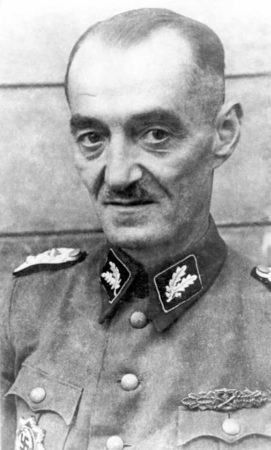
SS-Oberführer Dirlewanger was a psychopathic killer, “violently sadistic,” and an “expert in extermination and a devotee of sadism and necrophilia.” Even the most hardened Nazis thought his actions were too cruel. Arrested by the French in June 1945, Dirlewanger died in captivity a month later at the Detention Center Altshausen, likely at the hands of Polish interrogators.
Soviet Snipers
On 23 August 1939, Nazi Germany signed the German-Soviet Nonaggression Pact with Stalin. This gave Hitler the green light to invade Poland one week later and the world was plunged into war. Hitler broke the treaty on 22 June 1941 when his troops invaded the Soviet Union under Operation Barbarossa. At that point, Stalin was put on the defensive and forced to throw whatever he could at the rapidly advancing German army.
Unlike most western countries fighting Hitler, the Soviets were not squeamish about allowing women to join the men on the front lines. However, the women encountered male prejudice and ridicule while having to wear “hand-me-down” mens’ clothes. That all changed when the men saw the bravery, professionalism, and fighting ferocity displayed by the female soldiers and aviators.
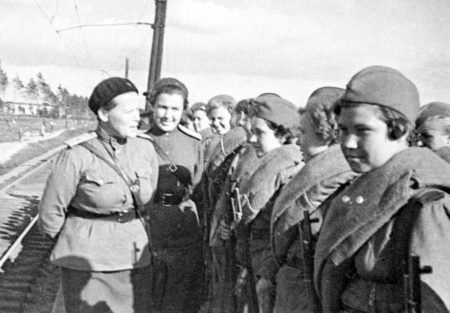
One of the infantry units the Soviets formed after Operation Barbarossa was the 25th Rifle Division for the purpose of training and deploying snipers. In March 1942, the Central Women’s School of Sniper Training was established about nine miles outside Moscow. Recruitment requirements were that the women had to be 18 to 26, physically fit, and have at least seven years of education. Sniper trainees were taught to dig a foxhole, crawl on their stomachs, and determine wind speed, distance, and movement of a target. Most importantly, the sniper graduates could assemble and disassemble their rifles with eyes shut.
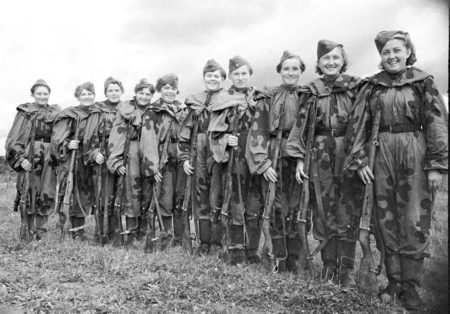
Snipers exhibited similar characteristics: reticent, bordering on introverted, shy of publicity and focused on doing their job. They also possessed a great amount of patience and an innate cunning. Snipers were not expected to draw attention to themselves. Their survival depended on how well they could stay hidden. As the war progressed, the perception of snipers (particularly, the women) changed from being glorified riflemen to professional front-line specialists. Their status allowed them one day off each week⏤an unheard-of concession in the Soviet army. Women snipers accounted for more than 12,000 official German kills. In all, two thousand women became snipers for the Soviet Union⏤only about five hundred survived the war.

Most of the Soviet snipers always saved one bullet in their pistol for themselves. If a sniper was caught alive (man or woman), they were tortured to death by the Germans.
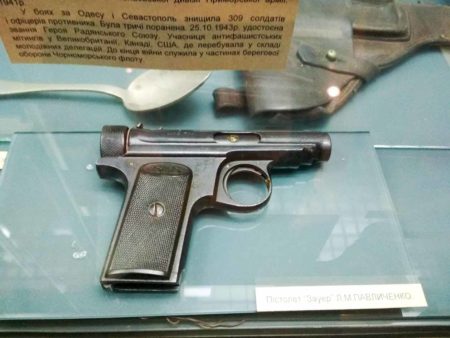

Lady Death
Lyudmila Mikhailovna Pavilichenko (1916−1974), or “Mila” as we will call her, was born in the Kiev Governorate in the Russian Empire. (Today, it is Kyiv, Ukraine.) She was always athletic and developed into an award-winning sharpshooter. By 1932, Mila had married and gave birth to a son. Unfortunately, the marriage fell apart and Mila returned home to her parents.
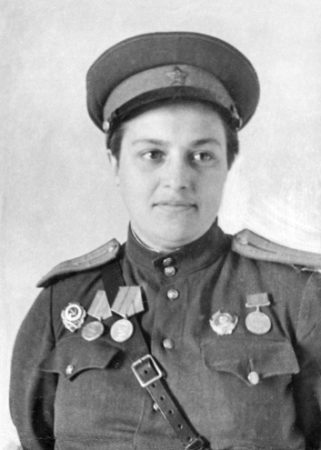
In 1937, Mila enrolled in one of the sniper schools run by the Soviet army. When Germany invaded the Soviet Union, Mila was accepted into the army as a sniper and initially assigned to the 25th Rifle Division. During the early years, weapons (of any type or quality) were hard to come by including rifles. In August 1941, Mila obtained a Mosin-Nagant model 1891 bolt-action rifle and proceeded to kill her first two targets. After that, Mila began to kill the hated Fascists at a prolific rate. She has been credited with 309 confirmed kills during her active duty. (A confirmed kill is one that was witnessed by a second person.) It is likely that the real number is much higher.
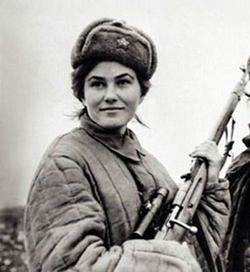
Mila was rapidly promoted and in 1941, she married a fellow sniper, Alexei Kitsenko. Her husband was killed shortly after the marriage and for the rest of her life, Mila never really recovered from the depression that accompanied losing Alexei. The 25th Rifle Division was sent to Sevastopol to fight the Germans during the siege of the city where Mila and other snipers accounted for more than one hundred kills during the battle. By May 1942, Lt. Pavlichenko was a legend in the Soviet army, and she became known as “Lady Death.”
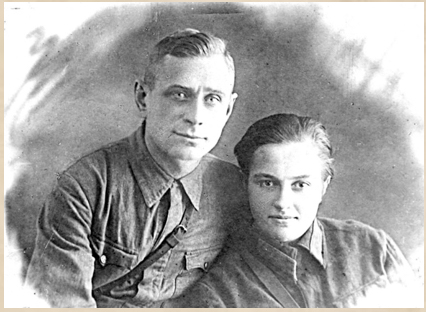
Mila was badly injured at Sevastopol and Stalin ordered her to be evacuated. After recovering, Mila become a propagandist for the Soviets and traveled to many of the Allied countries including America where President Roosevelt invited her to the White House. Upon her return and for the remainder of the war, Mila trained snipers.
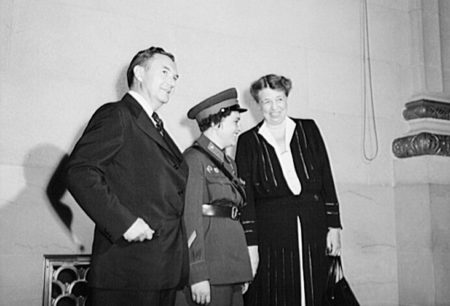

“Dead Little Hitlers”
Roza Shanina (1924−1945) was the first female sniper to be awarded the Soviet “Order of Glory.” She was considered one of the top snipers in the Soviet army having killed fifty-nine German soldiers in a ten-month period. Three days after arriving at the front, Roza killed her first German. She described the situation:
“Finally, in the evening a German showed in the trench. I estimated the distance to the target was not over 400 meters (437 yards). A suitable distance. When the Fritz, keeping his head down, went toward the woods, I fired, but from the way he fell, I knew I had not killed him. For about an hour the fascist lay in the mud, not daring to move. Then he started crawling. I fired again and this time, did not miss.”
After only ten months on the Eastern front, 20-year-old Roza was found dead slumped over a wounded officer trying to protect him. Her chest had been blown open by a German mortar shell. Roza’s diary and letters were released in 1965 for publication and her contributions to fighting the Germans became well-known.
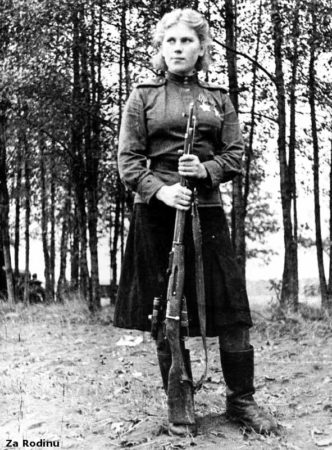
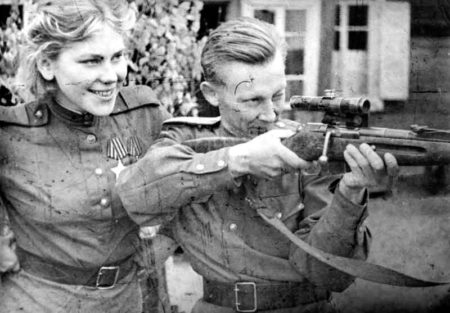
The Russian Celebrity and Actress
Ziba Ganiyeva (1923−2010) was a Soviet celebrity and actress prior to World War II. She fought in the 3rd Moscow Communist Rifle Division as a sniper. Ziba crossed behind enemy lines sixteen times and is credited with twenty-one German soldiers killed during the Battle of Moscow. Ziba was seriously wounded and spent eleven months recuperating in a hospital. She was awarded the Orders of the Red Banner and the Red Star. After the war, Ziba went on to obtain her degree in philology.
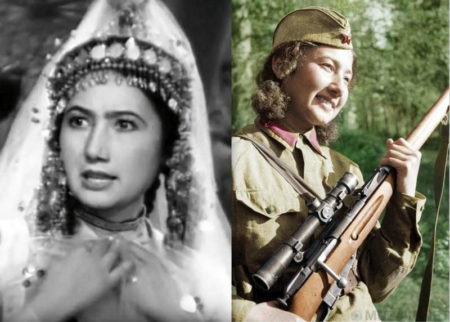
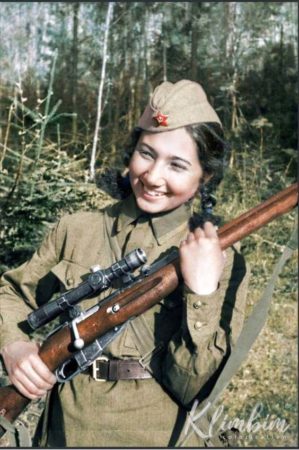
“We Mowed Down Hitlerites Like Ripe Grain”
Nadezhda Kolesnikova (1921-unknown) volunteered in 1943 to serve as a sniper on the Volkhovsky Eastern Front. She was credited with nineteen kills and awarded the “For Courage” medal.
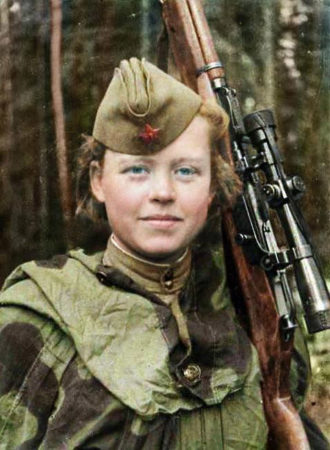
Lyuba Makarova was another top sniper. She participated in the support of the Third Shock army on the Kalinin Front in 1943. Sgt. Makarova killed 84 German soldiers and like Mila, she enjoyed shooting them in the stomach first before finishing off the job. She was awarded the “Order of Glory.”
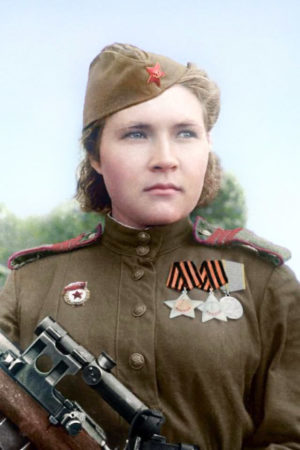
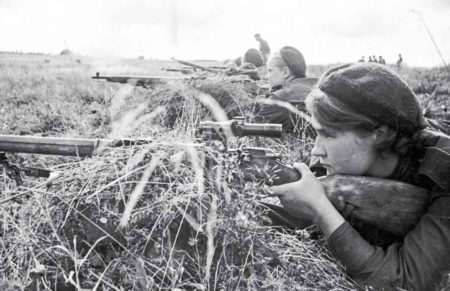
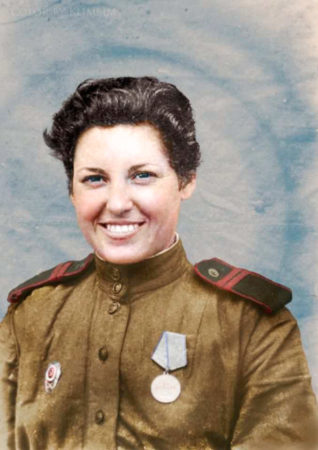
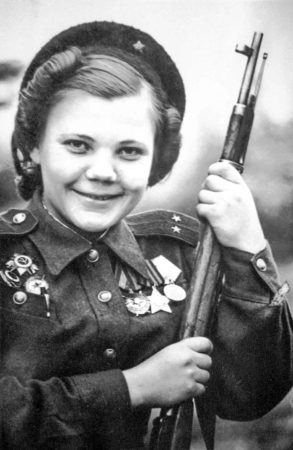
Post-War
After the war, Mila became one of the most highly decorated women to serve in the Soviet army. She received the Order of Lenin twice and was designated a “Hero of the Soviet Union.” Mila finished her education and became a historian and author working for the Soviet navy. Eleanor Roosevelt visited Moscow in 1957 and made a point of visiting with Mila whom she had met during the war in Washington D.C.
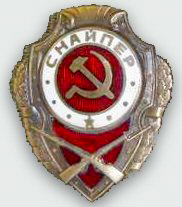
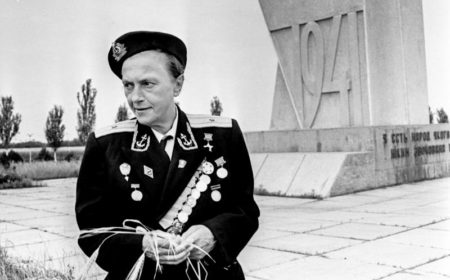
Largely due to the depression she suffered, Mila became an alcoholic and was burdened with post-traumatic stress disorder (PTSD). These problems likely led to her early death at the age of fifty-eight. Her ashes are buried in the columbarium at Novodevichy Cemetery in Moscow with her son, Rostislav (1932−2007), buried next to her. After Mila’s death, a government ship was named after her as were streets and schools.
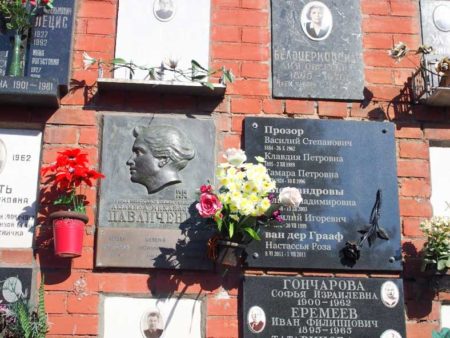
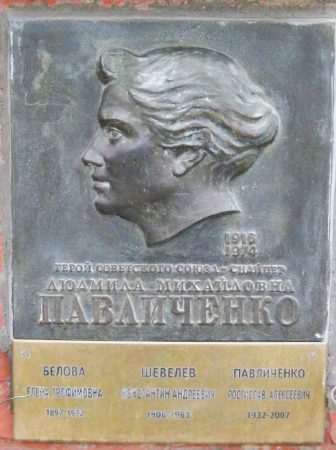
Soviet Photographs
Stalin used his female soldiers and aviators for propaganda purposes. As I determined with many of the images used in the blog, The Night Witches (click here to read the blog), quite a few of the photos used here have been staged. I really don’t think a sniper would want a photographer hovering over them while lining up a “kill” shot. But I’ll let you be the judge of that.
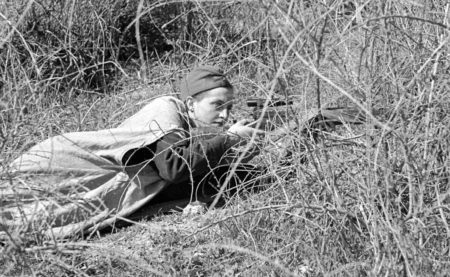
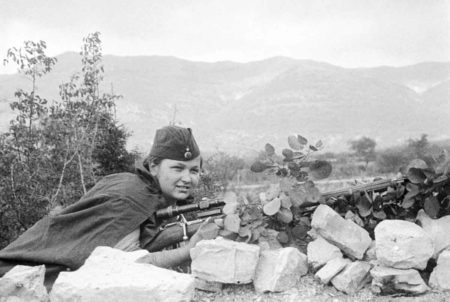
Next Blog (2 July): KZ Illustrators
★ Learn More About Soviet Snipers ★
Farey, Pat and Mark Spicer. Sniping: An Illustrated History. ZenithPress, 2009.
Pavlichenko, Lyudmila. Translated by David Foreman. Lady Death: The Memoirs of Stalin’s Sniper. Yorkshire: Greenhill Books, 2018. (Originally published by Veche Publishers, Moscow, 2015).
Sakaida, Henry. Heroines of the Soviet Union 1941−45. Oxford: Osprey Publishing, 2012.
Quinn, Kate. The Diamond Eye. New York: William Morrow, 2022.
Vinogradova, Lyuba. Translated by Arch Tait. Avenging Angels: Soviet Women Snipers on the Eastern Front (1941−45). London: MacLehose Press, 2017.
Walter, John. The Sniper Encyclopaedia: An A-Z Guide to World Sniping. Oxford: Casemate Group, 2018.
Disclaimer:
There may be a chance that after we publish this particular blog, the video links associated with the blog are no longer accessible. We have no control over this. Many times, whoever posts the video has done so without the consent of the video’s owner. In some cases, it is likely that the content is deemed unsuitable by YouTube. We apologize if you have tried to access the link and you don’t get the expected results. Same goes for internet links.
What’s New With Sandy and Stew?
As you read this Sandy and I are sitting on an airplane on our way home from Europe. (That is, provided we can find a place in Glasgow to get a COVID test one day prior to entering the states.) Obviously, I’m writing this prior to us returning so I will have to wait several weeks for our next blog to begin talking about our adventures in Paris, London, and Glasgow.
Thank you to all of you who subscribe to our bi-weekly blogs. It seems there isn’t a day that goes by where we don’t increase our readership. Please let your history buff friends and family members know about our blog site and blogs.
Someone Is Commenting On Our Blogs
Thanks to our good friend, Greg S., for his comment on the blog, S-Bahn Serial Killer (click here to read). He rated it a “Two thumbs up!”
If there is a topic you’d like to see a blog written about, please don’t hesitate to contact me. I love hearing from you so keep those comments coming.
Share This:
Follow Stew:
Find Stew’s books on Amazon and Apple Books.
Please note that we do not and will not take compensation from individuals or companies mentioned or promoted in the blogs.
 Walks Through History
Walks Through History
Copyright © 2022 Stew Ross

